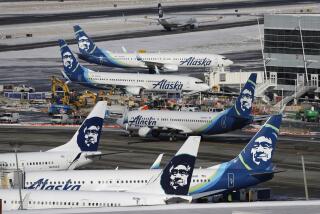NTSB investigates whether Asiana pilot was blinded before crash
Officials are investigating whether the pilot of the Asiana Airlines jet that crashed into the runway at San Francisco International Airport on Saturday had been blinded seconds before by a flash of light.
The pilot flying the plane, a veteran captain still in training on the Boeing 777, reportedly told Korean investigators that a bright flash temporarily blinded him at an altitude of about 500 feet.
National Transportation Safety Board director Deborah A.P. Hersman said pilot Lee Kang-kook shared “some of that information” with the U.S. investigators interviewing the pilots. When asked it if was a laser, she said investigators weren’t yet sure.
“We really don’t know what it could have been,” Hersman said. “We need to look into it. We need to understand what he’s talking about.”
At the same altitude, the pilots realized the jet was coming in too low, and tried to correct their path. The speed of the airplane also slowed significantly at that altitude, from about 134 knots (154 mph) at 500 feet, to 118 knots (136 mph) at 200 feet, to 112 knots (129 mph) at 125 feet.
During the briefing, Hersman outlined other aspects of the ongoing investigation, including a deeper analysis of the plane’s automated flight systems to determine how they interacted, whether the pilots used them properly or if they malfunctioned during the landing.
Noting that the Boeing 777 has some of the most sophisticated automation in the sky, Hersman said the systems, such as the auto-throttles, have many settings and can be coupled with one another.
Investigators found that in the 2-1/2 minutes before the crash, multiple auto-throttle modes and multiple auto-pilot modes had been set.
“What was the final mode the airplane was in?” Hersman asked. “We still need to validate the data. We need to make sure how the devices were set and what the pilots understood the modes to be.”
The evacuation of more than 300 people aboard the jetliner did not begin until 90 seconds after the aircraft came to rest and only when fire was spotted by a flight attendant, federal investigators said.
Getting everyone out of the wide-body 777 late Saturday morning also was complicated by two escape slides that inflated in the cabin, pinning down two crew members, as the plane careened down Runway 28L.
The accident killed two teenage girls from China who were coming to Los Angeles for a summer camp. Scores more were injured.
ALSO:
NTSB to investigate delayed evacuation of Asiana flight
Asiana flight 911 tapes: Commuters, hikers reported crash
Days after Asiana crash, FAA to require more training for co-pilots
More to Read
Sign up for Essential California
The most important California stories and recommendations in your inbox every morning.
You may occasionally receive promotional content from the Los Angeles Times.











